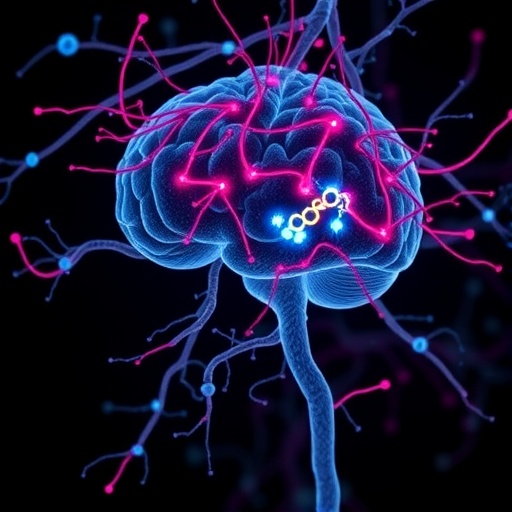In a groundbreaking study published in BMC Psychiatry, researchers have unveiled compelling evidence connecting nitric oxide (NO)-induced neuronal pyroptosis with schizophrenia and its associated cognitive decline. Schizophrenia (SZ), a chronic and severely debilitating psychiatric disorder, continues to puzzle the scientific community due to its multifaceted pathology and elusive therapeutic targets. This investigation bridges a crucial gap by elucidating how NO—a small, diffusible signaling molecule—triggers a specific form of programmed neuronal cell death called pyroptosis, potentially driving both the pathogenesis of SZ and its profound cognitive impairments.
The research team employed a multi-layered approach combining in vitro experiments on neuronal cells with clinical analyses involving SZ patients and matched healthy controls. Utilizing the SH-SY5Y neuroblastoma cell line, the study first demonstrated that exposure to sodium nitroprusside, a well-known NO donor, significantly diminished neuronal viability in a dose-dependent manner. At an IC50 concentration of 1.4 mM, sodium nitroprusside induced a marked shift in the expression of genes integral to pyroptosis—such as NLRP3, Caspase-1, and GSDMD—as well as genes implicated in SZ susceptibility, including CUX2 and DTNBP1. These molecular alterations hint at a mechanistic pathway whereby NO fuels neuroinflammation and exacerbates neuronal damage.
Clinically, the study recruited 58 individuals diagnosed with schizophrenia alongside 62 healthy controls, assessing peripheral blood markers and cognitive function with the RBANS (Repeatable Battery for the Assessment of Neuropsychological Status). Notably, SZ patients exhibited elevated systemic NO levels, which correlated with upregulated expression of pyroptosis-related genes and inflammatory mediators like IL-1β and IL-18. Intriguingly, dysregulation of NLRP3 and IL-18 showed a robust association with cognitive deficits, underscoring the potential of these molecules as biomarkers or therapeutic targets for cognitive impairment in schizophrenia.
The concept of pyroptosis, a highly inflammatory form of programmed cell death distinct from apoptosis and necrosis, has recently garnered attention in neuropsychiatric research. Characterized by the activation of inflammasomes such as NLRP3, pyroptosis culminates in cell membrane rupture and the release of pro-inflammatory cytokines. The study’s findings elucidate that NO, at pathological levels, may instigate this cascade, causing neuronal loss and widespread inflammation that likely contributes to the cognitive dysfunction prevalent in SZ. This represents a shift from traditional neurotransmitter-centric models to embracing neuroimmune and cell death pathways as central players.
Moreover, the identification of elevated NO as a driver of pyroptotic activity in neurons aligns with emerging data linking oxidative and nitrosative stress to psychiatric disease progression. Given NO’s dual role in normal physiological signaling and pathological damage, therapeutic modulation requires precision. Targeting the NLRP3 inflammasome or downstream effectors—such as IL-18—may mitigate neuroinflammation without compromising essential neuronal signaling, paving the way for novel interventions.
In terms of translational impact, this research opens the door to developing blood-based biomarkers that reflect central nervous system processes, facilitating early detection and stratification of patients at risk for cognitive decline. Additionally, the study reinforces the importance of anti-inflammatory strategies in SZ management, complementing existing antipsychotic treatments that primarily address psychotic symptoms but have limited efficacy in preserving cognitive function.
The synergy observed between susceptibility genes like CUX2 and DTNBP1 and inflammasome activation provides a genetic underpinning linking inherited risk to molecular and cellular pathology. This integrative perspective marries genetics, immunology, and neurobiology, fostering a more holistic understanding of schizophrenia that could guide personalized medicine approaches.
While this investigation significantly advances the field, further research is warranted to delineate the temporal dynamics of NO-induced pyroptosis in vivo, verify causality in longitudinal studies, and explore therapeutic agents that can safely inhibit inflammasome pathways in the human brain. The study also raises intriguing questions about whether similar mechanisms operate in other neuropsychiatric disorders marked by cognitive impairment.
In conclusion, the elucidation of nitric oxide’s role in triggering neuronal pyroptosis offers a transformative insight into schizophrenia’s complex pathology. By identifying NLRP3 and IL-18 as pivotal mediators linking neuroinflammation to cognitive deficits, this study provides a promising roadmap for future research and treatment development. As our understanding deepens, this paradigm shift holds the potential to alleviate the cognitive burden endured by millions worldwide living with schizophrenia.
—
Subject of Research: The role of nitric oxide-induced neuronal pyroptosis in schizophrenia and its associated cognitive impairment.
Article Title: Research on the correlation of nitric oxide-induced neuronal cell pyroptosis with schizophrenia and its cognitive impairment.
Article References:
Lei, M., Tian, Y., Teng, Z. et al. Research on the correlation of nitric oxide-induced neuronal cell pyroptosis with schizophrenia and its cognitive impairment. BMC Psychiatry 25, 890 (2025). https://doi.org/10.1186/s12888-025-07333-x
Image Credits: AI Generated
DOI: https://doi.org/10.1186/s12888-025-07333-x
Keywords: schizophrenia, nitric oxide, neuronal pyroptosis, NLRP3 inflammasome, cognitive impairment, neuroinflammation, IL-18, Caspase-1, GSDMD, CUX2, DTNBP1, sodium nitroprusside, RBANS.




